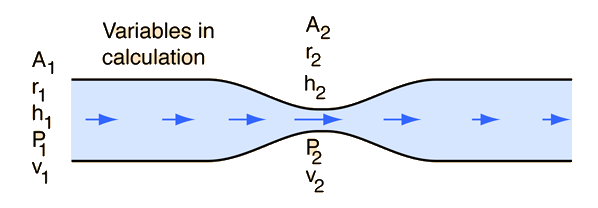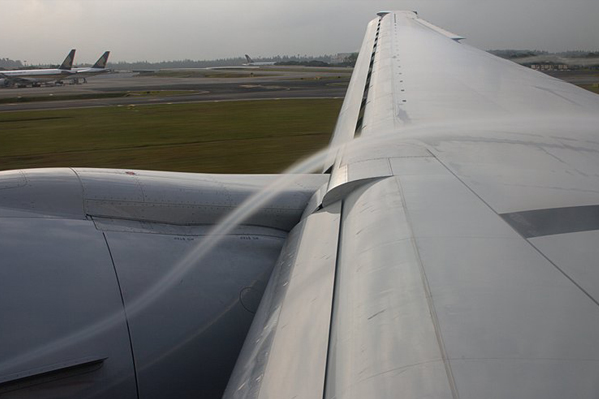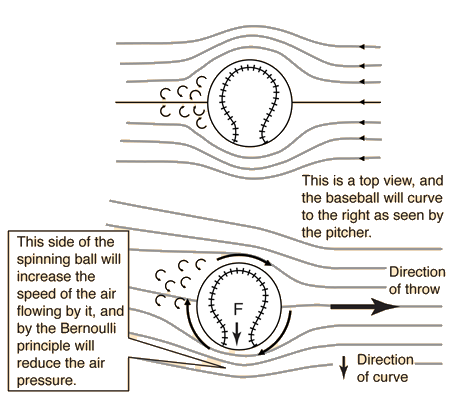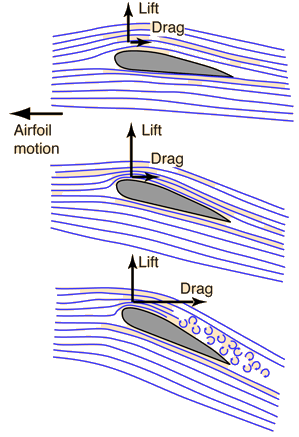고정 헤더 영역
상세 컨텐츠
본문
Bernoulli EquationThe Bernoulli Equation can be considered to be a statement of the conservation of energy principle appropriate for flowing fluids. The qualitative behavior that is usually labeled with the term "Bernoulli effect" is the lowering of fluid pressure in regions where the flow velocity is increased. This lowering of pressure in a constriction of a flow path may seem counterintuitive, but seems less so when you consider pressure to be energy density. In the high velocity flow through the constriction, kinetic energy must increase at the expense of pressure energy. 
Bernoulli calculation |
Index Bernoulli concepts | ||
|
Go Back |
Bernoulli CalculationThe calculation of the "real world" pressure in a constriction of a tube is difficult to do because of viscous losses, turbulence, and the assumptions which must be made about the velocity profile (which affect the calculated kinetic energy). The model calculation here assumes laminar flow (no turbulence), assumes that the distance from the larger diameter to the smaller is short enough that viscous losses can be neglected, and assumes that the velocity profile follows that of theoretical laminar flow. Specifically, this involves assuming that the effective flow velocity is one half of the maximum velocity, and that the average kinetic energy density is given by one third of the maximum kinetic energy density. |
Index Bernoulli concepts | ||
|
Go Back |
Curve of a BaseballA non-spinning baseball or a stationary baseball in an airstream exhibits symmetric flow. A baseball which is thrown with spin will curve because one side of the ball will experience a reduced pressure. This is commonly interpreted as an application of the Bernoulli principle and involves the viscosity of the air and the boundary layer of air at the surface of the ball.
There are some difficulties with this picture of the curving baseball. The Bernoulli equation cannot really be used to predict the amount of curve of the ball; the flow of the air is compressible, and you can't track the density changes to quantify the change in effective pressure. The experimental work of Watts and Ferrer with baseballs in a wind tunnel suggests another model which gives prominent attention to the spinning boundary layer of air around the baseball. On the side of the ball where the boundary layer is moving in the same direction as the free stream air speed, the boundary layer carries further around the ball before it separates into turbulent flow. On the side where the boundary layer is opposed by the free stream flow, it tends to separate prematurely. This gives a net deflection of the airstream in one direction behind the ball, and therefore a Newton's 3rd law reaction force on the ball in the opposite direction. This gives an effective force in the same direction indicated above. Similar issues arise in the treatment of a spinning cylinder in an airstream, which has been shown to experience lift. This is the subject of the Kutta-Joukowski theorem. It is also invoked in the discussion of airfoil lift. |
Index Bernoulli Equation Bernoulli concepts Reference Watts and Ferrer | ||
|
Go Back |
AirfoilThe air across the top of a conventional airfoil experiences constricted flow lines and increased air speed relative to the wing. This causes a decrease in pressure on the top according to the Bernoulli equation and provides a lift force. Aerodynamicists (see Eastlake) use the Bernoulli model to correlate with pressure measurements made in wind tunnels, and assert that when pressure measurements are made at multiple locations around the airfoil and summed, they do agree reasonably with the observed lift.
 A vapor trail over the wing helps visualize the air flow. Photo by Frank Starmer, used by permission. |
Index Bernoulli Equation References Eastlake  NASA Aerodynamics | |||||
|
Go Back |






